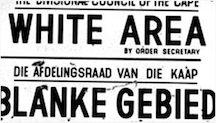As the recipient of much anger from the white liberal echelon to the intolerant right, I was relieved to be sent this link by a Facebook friend and anti-racism activist from Canada.
The writer of this blog has extrapolated the essential messages from Professor Barnor Hesse’s course “Unsettling Whiteness”.
This is ground-breaking work around whiteness studies from a radical black perspective. In it he outlines the eight categories of white identity in relation to the “regime of whiteness that governs society through racial rule”. These are the “socially visible, action-orientated white identities in everyday dialogue within that regime”.
My relief at reading this model lies in the fact that there is a lack of vocabulary and real discussion and debate around whiteness in the public sphere in South Africa. White people generally do not want to be challenged on issues of supremacy or the invisible privilege of whiteness. We also do not have public intellectuals really tackling the issue of whiteness in an accessible manner. Rather it has become an intellectual affair that takes place in university settings and colloquiums.
On a personal note I also found the many different types of responses to my essays on whiteness both fascinating and puzzling and have been mulling over this for some time. Why, for example, did my ‘Dear white people” letter, enrage liberals who admonished me for “tone” (thought they supposedly agreed with content). What was this tone that they imagined was there? Why did people who agreed with and celebrated the letter, not feel this “scorching” “humourless”, “lacking in irony” tone, but read it as honest and sometimes wry, and even found elements of humour or literary conceit where others only saw insult?
Why did many black people celebrate the letter and many white people resort to insults and death threats or scathing sarcastic responses in their own liberal columns? Why too do some white gatekeepers insist that I speak on behalf of black people when I speak of whiteness to white people? There is a huge difference in speaking about white responses to blackness than there is in usurping platforms for black voices – and it is those “development people” who are always writing articles about the poor, with no suggestion of the poor speaking for themselves, who are the one’s speaking on behalf of blackness. How was this contradiction so utterly overlooked in their critique of my work?
For me it became less about the letter and more about the responses to it that drew me into a vortex of analysis and conjecture.
What did become clear to me in these multifarious responses though, was the fact that everyone who responded did so from their understanding of what whiteness is and that made it very evident that there are multiple white identities as well as multiple understandings of racism and privilege in the wider public. There are also variant ideas as to what constitutes anti-racism.
Despite what certain commentators would have us believe it is clear that whiteness is not a homogeneous phenomenon, just as blackness is not.
This list of the 8 categories of white identity provided me with a model with which to work out this rubric cube of white (and other) responses to my work. In short, I finally found a framework with which to extrapolate the texture, tone and tendency of the varied responses I received to that letter and to most of my work.
Here is a further extrapolation of the model of 8 categories of white identity by Native NUance. Where do you fit in?
1. Are you a White Supremacist who maintains and advocates a clearly marked white society that preserves, names, and values white superiority?
2. Are you into White Voyeurism? This means being a White Voyeur who would not challenge a white supremacist’s stated beliefs. They desire non-whiteness because it is interesting and pleasurable to them, and they seek to control the consumption and appropriation of non-whiteness. They may express a fascination with culture, for example: consuming black culture without the burden of blackness; consuming and appropriating Native American cultures, clothing, or spiritualities without the burden of racism or prejudice.
3. Do you cling to your White Privilege? A White Privileged person may critique white supremacy, but they maintain a deep investment in questions of “fairness” and “equality” that normalise whiteness and white rule. They may have a sworn goal of “diversity’.
4. Are you into White Benefit? A White Benefit person is sympathetic to some aspects of anti-racism, but only privately. They will not speak or act in solidarity publicly, because they are benefitting through whiteness in public.
5. Or is the White Confessional your thing? A White Confessional person will speak about and point out whiteness to some extent, but only as a way of being accountable to people of colour after the fact. A White Confessional seeks validation from people of colour.
6. Could you be a White Critical? A White Critical person will take on board critiques of whiteness and invest in exposing and marking the regime of whiteness. They refuse to be complicit with the regime, and might be seen as whiteness speaking back to whiteness.
7. Are you a White Traitor? A White Traitor actively refuses complicity in the regime of whiteness, names and speaks about what is going on, and intends to subvert white authority and tell the truth at whatever cost.
8. And just how many actual White Abolitionists are out there? A White Abolitionist changes institutions that are historically based on white rule, dismantles the regime of whiteness, and does not allow the regime or white rule to reassert itself.
Over the next few weeks I am going to be writing about these categories within the South African context. In the meantime please feel free to continue to insult me … or just be brave enough to own your category of whiteness and think about how this impacts on the people around you.



